基于不同部署策略最大限度地提高无线传感器网络寿命与异质性分布式算法及可调节感应范围(IJITCS-V5-N8-10)
无线传感器网络技术的发展

无线传感器网络技术的发展随着物联网时代的来临,无线传感器网络技术得到了广泛的应用。
它是人们在社会、经济、环保等领域中探索解决问题的一种有效手段,也是未来智能城市建设的重要基础。
一、无线传感器网络技术的概述无线传感器网络(Wireless Sensor Network,WSN)是由大量无线传感器节点组成的网络,是将传感器、处理器和通信技术融合在一起的高新技术。
它通过传感器节点采集环境信息,通过通信模块将信息传送到决策中心,实现对环境进行感知、监测、控制等操作。
二、无线传感器网络技术的发展历程无线传感器网络技术在20世纪80年代开始,随着计算机和通信技术的发展而不断进步。
在20世纪90年代初,无线传感器网络开始应用于石化工业、农业、自然环境监测等领域。
2000年初,美国西北大学成立第一个无线传感器网络实验室,推动了该领域的发展。
近年来,在无线通信技术、自组织网络技术、传感器技术等方面的不断发展,无线传感器网络得以广泛应用。
三、无线传感器网络技术的优势1. 低成本。
由于采用的是小型化单元,无线传感器网络的成本相对较低。
2. 自组织。
无线传感器网络具有自组织和自修复的能力,在网络节点出现故障时可自动调整网络拓扑结构,保证了网络的稳定性和可靠性。
3. 简便易用。
无线传感器网络具有较好的用户接口性,方便用户使用。
4. 数据处理能力。
无线传感器网络具有较强的数据处理能力,可以对节点传来的大量数据进行处理和分析。
四、无线传感器网络技术的应用领域1. 环境监测。
无线传感器网络技术可以实现对大气、水质、土壤等环境指标的自动监测,提高环境监测效率。
2. 工程安全监测。
无线传感器网络技术可以实现对建筑物、桥梁、公路等工程的安全监测,提高工程安全性。
3. 农业生产。
无线传感器网络技术可以自动监测农作物的生长情况,帮助农民根据监测数据实施合理的农业生产措施。
4. 物流和仓储管理。
无线传感器网络技术可以实现对物流和仓储环节的全面监测,提高物流和仓储管理水平。
无线传感器网络LEACH算法的改进
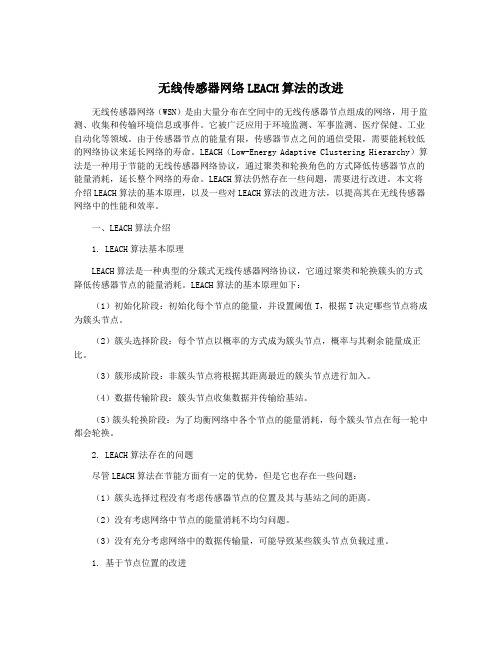
无线传感器网络LEACH算法的改进无线传感器网络(WSN)是由大量分布在空间中的无线传感器节点组成的网络,用于监测、收集和传输环境信息或事件。
它被广泛应用于环境监测、军事监测、医疗保健、工业自动化等领域。
由于传感器节点的能量有限,传感器节点之间的通信受限,需要能耗较低的网络协议来延长网络的寿命。
LEACH(Low-Energy Adaptive Clustering Hierarchy)算法是一种用于节能的无线传感器网络协议,通过聚类和轮换角色的方式降低传感器节点的能量消耗,延长整个网络的寿命。
LEACH算法仍然存在一些问题,需要进行改进。
本文将介绍LEACH算法的基本原理,以及一些对LEACH算法的改进方法,以提高其在无线传感器网络中的性能和效率。
一、LEACH算法介绍1. LEACH算法基本原理LEACH算法是一种典型的分簇式无线传感器网络协议,它通过聚类和轮换簇头的方式降低传感器节点的能量消耗。
LEACH算法的基本原理如下:(1)初始化阶段:初始化每个节点的能量,并设置阈值T,根据T决定哪些节点将成为簇头节点。
(2)簇头选择阶段:每个节点以概率的方式成为簇头节点,概率与其剩余能量成正比。
(3)簇形成阶段:非簇头节点将根据其距离最近的簇头节点进行加入。
(4)数据传输阶段:簇头节点收集数据并传输给基站。
(5)簇头轮换阶段:为了均衡网络中各个节点的能量消耗,每个簇头节点在每一轮中都会轮换。
2. LEACH算法存在的问题尽管LEACH算法在节能方面有一定的优势,但是它也存在一些问题:(1)簇头选择过程没有考虑传感器节点的位置及其与基站之间的距离。
(2)没有考虑网络中节点的能量消耗不均匀问题。
(3)没有充分考虑网络中的数据传输量,可能导致某些簇头节点负载过重。
1. 基于节点位置的改进通过引入节点位置信息,可以更合理地选择簇头节点,避免一些节点成为簇头节点后,由于其位置过远而导致能量消耗过大。
可以根据节点与基站之间的距离进行簇头节点的选择,以减少能量消耗。
网络可靠性分析

网络综合可靠度
为了进一步分析网络的可靠度,需要考 虑网络承载的业务。
下面以电话网为例,考虑网络平均呼损 的计算。在4.4中已讨论电话网络平均呼 损的计算方法,不过在4.4中并没有考虑 网络故障因素。考虑故障因素的电话网 络平均呼损也可被称之为综合不可靠度。
n
连通度的辅助指标
为了更加细致地描述图的可靠性,引入 三个辅助指标。它们的定义如下:
定义7.3 C =最小割端集的数目; B =最小割边集的数目; A =最小混合割集的数目;
可靠性指标的计算
例7.5 下图中(a) ,(b) ,(c)三个图,分别计算它 们的各种可靠性指标。
(a)
(b)
网络在只有端故障下的近似可靠度
首先,假设网络仅有端故障,Ci (i ) 表示 有 i 个割端的割端集的数目。此时,网 络的不可靠集可以按照割端集来分类, 由于各个端点的故障独立,网络可靠度 可以计算如下:
n
R(n) 1 Ci qi (1 q)ni i
网络近似可靠度
由于 q 1,保留最大的项,则有:
两端之间的可靠度
考虑图的某两个端s和t,所谓s和t之间的 可靠度是指s和t之间有路径相通的概率。
这个概率的近似计算类似网络可靠度的 计算。如果各边、端的可靠度不一样, 并且网络规模不大,也可以对可靠度做 准确计算。
7.4 网络综合可靠度
在7.2中讨论了通信网的各种连通度以及一些辅 助指标,这些指标仅仅依赖于拓扑结构,是对 可靠性的确定性度量。
的混接系统,若第 i 个子系统的可靠度
基于遗传算法的无线传感器网络节点部署优化研究
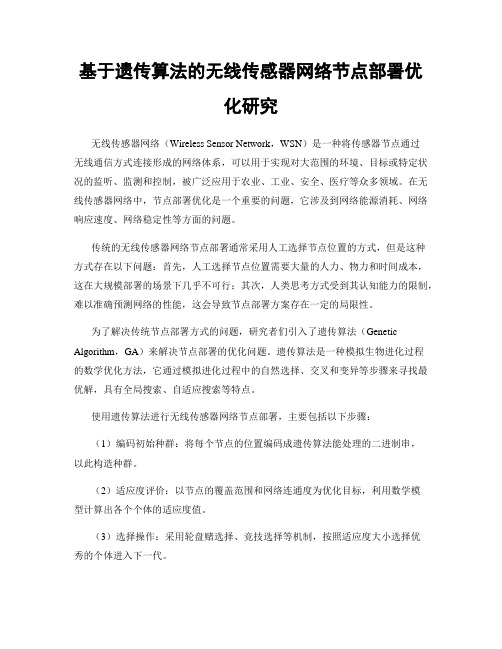
基于遗传算法的无线传感器网络节点部署优化研究无线传感器网络(Wireless Sensor Network,WSN)是一种将传感器节点通过无线通信方式连接形成的网络体系,可以用于实现对大范围的环境、目标或特定状况的监听、监测和控制,被广泛应用于农业、工业、安全、医疗等众多领域。
在无线传感器网络中,节点部署优化是一个重要的问题,它涉及到网络能源消耗、网络响应速度、网络稳定性等方面的问题。
传统的无线传感器网络节点部署通常采用人工选择节点位置的方式,但是这种方式存在以下问题:首先,人工选择节点位置需要大量的人力、物力和时间成本,这在大规模部署的场景下几乎不可行;其次,人类思考方式受到其认知能力的限制,难以准确预测网络的性能,这会导致节点部署方案存在一定的局限性。
为了解决传统节点部署方式的问题,研究者们引入了遗传算法(Genetic Algorithm,GA)来解决节点部署的优化问题。
遗传算法是一种模拟生物进化过程的数学优化方法,它通过模拟进化过程中的自然选择、交叉和变异等步骤来寻找最优解,具有全局搜索、自适应搜索等特点。
使用遗传算法进行无线传感器网络节点部署,主要包括以下步骤:(1)编码初始种群:将每个节点的位置编码成遗传算法能处理的二进制串,以此构造种群。
(2)适应度评价:以节点的覆盖范围和网络连通度为优化目标,利用数学模型计算出各个个体的适应度值。
(3)选择操作:采用轮盘赌选择、竞技选择等机制,按照适应度大小选择优秀的个体进入下一代。
(4)交叉操作:对选中的个体进行交叉运算,生成新的后代个体。
(5)变异操作:在新生个体中随机选择某些位进行变异,增加种群的多样性。
(6)更新种群:使用新的个体替代部分原来的个体,更新种群。
(7)判断终止条件:根据指定的终止准则,判断是否达到了终止条件,如果没有,返回第(2)步;如果达到,输出最优解。
在实现无线传感器网络节点部署优化时,遗传算法可用于优化节点布置、协调路由、网络构建等方面,可以使节点覆盖范围更广、网络性能更稳定,提高了无线传感器网络的适应性和灵活性,适用于更广范围的应用场景。
无线传感器网络的能耗优化与性能提升

无线传感器网络的能耗优化与性能提升无线传感器网络(Wireless Sensor Networks, WSN)是由分布在空间中的大量无线传感器节点组成的网络。
传感器节点具有自主感知、处理和通信能力,可以采集区域内的环境信息并进行处理和传输。
然而,由于节点数量众多、能源有限、通信链路不稳定等因素的制约,如何优化能源消耗,提升性能成为无线传感器网络中的重要问题。
一、能耗优化1. 路由选择算法优化:选择适当的路由选择算法,可以降低能耗。
例如,LEACH(Low-Energy Adaptive Clustering Hierarchy)是一种典型的基于分簇的路由协议,通过动态地选择簇头节点来减少传输功耗,延长网络寿命。
2. 能量平衡机制:通过合理地分配能量消耗,确保网络中各节点的能量消耗均衡,延长整个网络的寿命。
例如,可以采用动态功率调整的方法,使得距离簇头节点较近的节点使用较低功率,距离较远的节点使用较高功率。
3. 节能的数据传输策略:传感器节点通过无线信道进行数据传输需要消耗大量的能量,因此需要采取合适的数据传输策略来降低能耗。
例如,可以采用数据聚合和压缩的方法,在传输前对数据进行处理,减少数据的传输量和传输次数。
4. 省能模式设计:设计合理的省能模式可以降低节点的能耗。
例如,可以采用休眠-唤醒机制,节点在无数据传输时进入休眠状态以节省能量,并在需要传输数据时及时唤醒。
二、性能提升1. 网络拓扑优化:通过优化网络拓扑结构,可以提升网络的整体性能。
例如,可以采用分簇结构,减少通信距离和能耗,提高网络的可扩展性和吞吐量。
2. 自适应传输机制:根据环境和网络状态的变化,自适应地调整传输参数,可以提升网络的性能。
例如,可以根据当前网络的负载情况和信道条件来动态调整传输速率和功率。
3. 多路径传输策略:通过采用多路径传输策略,可以提高数据的传输可靠性和可用性。
例如,可以通过多路径选择和数据重传机制,实现数据的多路径冗余传输,降低数据丢失的风险。
无线传感器网络中节点部署优化算法研究
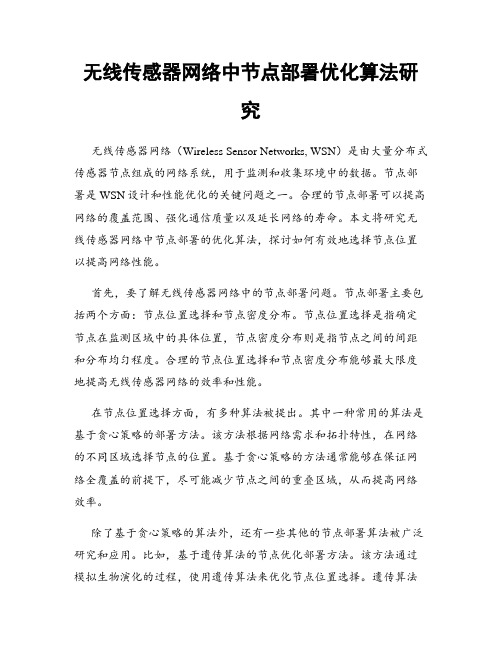
无线传感器网络中节点部署优化算法研究无线传感器网络(Wireless Sensor Networks, WSN)是由大量分布式传感器节点组成的网络系统,用于监测和收集环境中的数据。
节点部署是WSN设计和性能优化的关键问题之一。
合理的节点部署可以提高网络的覆盖范围、强化通信质量以及延长网络的寿命。
本文将研究无线传感器网络中节点部署的优化算法,探讨如何有效地选择节点位置以提高网络性能。
首先,要了解无线传感器网络中的节点部署问题。
节点部署主要包括两个方面:节点位置选择和节点密度分布。
节点位置选择是指确定节点在监测区域中的具体位置,节点密度分布则是指节点之间的间距和分布均匀程度。
合理的节点位置选择和节点密度分布能够最大限度地提高无线传感器网络的效率和性能。
在节点位置选择方面,有多种算法被提出。
其中一种常用的算法是基于贪心策略的部署方法。
该方法根据网络需求和拓扑特性,在网络的不同区域选择节点的位置。
基于贪心策略的方法通常能够在保证网络全覆盖的前提下,尽可能减少节点之间的重叠区域,从而提高网络效率。
除了基于贪心策略的算法外,还有一些其他的节点部署算法被广泛研究和应用。
比如,基于遗传算法的节点优化部署方法。
该方法通过模拟生物演化的过程,使用遗传算法来优化节点位置选择。
遗传算法能够根据网络需求和环境条件,在不同的演化代际中筛选和交叉节点位置,以适应不同的网络任务,从而提高网络性能。
在节点密度分布方面,也有很多研究。
一种常见的方法是根据环境特征和网络需求,将节点密度进行分层。
在感知到有意义的事件或数据时,高密度区域的节点将收集和传输更多的数据,而低密度区域的节点则保持静默状态。
这种分层的节点密度分布方法可以使得网络在资源有限的情况下,更好地适应不同的监测区域。
除了节点位置选择和节点密度分布,节点部署的优化算法还可以考虑一些其他因素,如能量平衡、网络容量和通信质量。
在节点能量平衡方面,可以采用能量均衡的部署方法,使得网络中的节点能量消耗更加均衡,从而延长整个网络的寿命。
无线传感网络的设计与优化

无线传感网络的设计与优化第一章:引言无线传感网络(Wireless Sensor Network,WSN)是一种由多个分布在空间中的传感器节点组成的自组织网络。
由于其具有低成本、低功耗、易于部署等特点,无线传感网络在环境监测、物联网等领域具有广泛的应用前景。
本文将探讨无线传感网络的设计与优化,包括传感器节点的布局、通信协议的选择以及能量管理等关键技术。
第二章:传感器节点布局无线传感网络的设计首先需要考虑传感器节点的布局问题。
传感器节点的密度和分布对网络性能有着重要影响。
合理地选择传感器节点的布局可以提高网络的覆盖范围和数据采集的准确性。
2.1 节点密度与网络覆盖传感器节点的密度取决于具体应用场景和需求。
对于需要高分辨率的应用,如火灾监测,传感器节点的密度应适当增加,以提高覆盖效果和传感数据的准确性。
而对于一些较大范围的应用,如农业环境监测,传感器节点的密度可以适当减少,以降低成本和能量消耗。
2.2 节点分布策略传感器节点的分布策略是保证网络性能的关键。
常用的节点分布策略有随机分布、均匀分布和优化分布。
随机分布可以快速部署传感器节点,但往往导致传感器节点的冗余和覆盖不均等问题。
均匀分布能够保证传感器节点的覆盖均匀性,但节点之间可能存在较长的通信距离。
优化分布则是通过数学模型和算法来确定传感器节点的最佳位置,以达到最优的网络性能。
第三章:通信协议的选择无线传感网络的通信协议选择直接影响着网络的能效和可靠性。
合适的通信协议能够在保证数据传输的同时尽量降低能量消耗。
3.1 能耗分析传感器节点在数据传输过程中的能耗主要包括发射能耗、接收能耗和待机能耗。
对于不同的传感器节点,其能耗分布可能有所差异。
针对不同的节点类型和应用场景,需要进行能耗分析,以便选择合适的通信协议。
3.2 通信协议选择常用的无线传感网络通信协议有LEACH、TEEN、PEGASIS等。
LEACH协议是一种典型的分簇路由协议,能够有效地降低能量消耗。
基于机器学习的无线传感器网络能源管理研究

基于机器学习的无线传感器网络能源管理研究近年来,无线传感器网络(WSN)在各个领域得到了广泛的应用和研究。
然而,WSN的能源管理问题一直是一个重要的挑战。
为了延长无线传感器网络的寿命,减少能源消耗,提高网络的性能和可靠性,基于机器学习的无线传感器网络能源管理成为了研究的热点。
本文将探讨基于机器学习的无线传感器网络能源管理的研究进展和应用前景。
首先,我们需要了解什么是无线传感器网络。
无线传感器网络是由大量的分布式传感节点组成的网络,这些节点可以感知环境中的各种信息,并通过无线通信传输数据。
然而,由于节点的数量众多、分布广泛,能量供应有限,能源管理成为了无线传感器网络的核心问题。
机器学习被广泛应用于无线传感器网络的能源管理中,它利用数据和统计分析方法,通过建模和分析网络中的信息,来实现智能化的能源管理策略。
通过学习网络的特征和能量消耗模型,机器学习能够预测节点的能量消耗情况,从而实现对能量的有效利用和分配。
在基于机器学习的能源管理中,有几个关键问题需要解决。
首先是能耗预测问题,即如何准确地预测节点的能耗情况。
传统的方法往往基于静态模型,无法适应网络的动态变化。
而机器学习可以通过学习历史数据和实时监测信息,构建准确可靠的能耗预测模型。
其次是能量分配问题,即如何根据节点的能耗情况合理地分配能量资源。
机器学习可以通过优化算法和决策模型,根据节点的能耗预测结果,智能地调整能量分配策略,实现网络中能量的平衡和最大程度的延长网络寿命。
基于机器学习的无线传感器网络能源管理还有其他一些研究方向。
例如,如何通过机器学习算法优化网络中的通信和传输协议,减少能源消耗。
另外,如何利用机器学习算法分析网络中的数据,提取有用的信息和特征,进一步优化能源管理策略。
此外,如何在节点资源有限的情况下,通过机器学习算法控制网络的负载和拓扑结构,达到节能的效果。
基于机器学习的无线传感器网络能源管理在实际应用中也取得了一定的成果。
例如,在农业领域中,利用机器学习算法分析土壤湿度和气温等数据,实现对灌溉系统的智能控制,提高了水资源的利用效率和农作物的产量。
无线传感器网络分簇路由算法的研究与改进的开题报告

无线传感器网络分簇路由算法的研究与改进的开题报告一、研究背景随着无线传感器网络技术的广泛应用,网络规模逐步增大,网络带宽和能量资源的限制也变得更加紧迫。
由于传感器节点的能量有限,因此如何有效地利用节点资源,延长网络寿命,成为无线传感器网络研究的关键问题之一。
在无线传感器网络中,簇路由是一种有效的能量管理和数据聚集方式。
簇头节点负责收集周围的数据,并将其汇聚到基站。
簇头节点和普通节点组成一个簇,其中簇头节点由其他节点选举。
然而现有的簇路由算法存在一些问题,比如算法复杂度高、能量分配不均等问题,这些问题会严重影响网络的性能和寿命。
因此,本人计划研究无线传感器网络分簇路由算法,通过改进现有的算法,提高算法的效率和能量利用率,降低节点能量消耗,延长网络寿命,在无线传感器网络应用中具有重要的理论研究价值和实际应用价值。
二、研究目的本次研究的目的是改进无线传感器网络分簇路由算法,提高算法性能和能量利用率,降低节点能量消耗,延长网络寿命。
具体目标如下:1. 综合现有簇路由算法的优势和不足,提出一种新的分簇路由算法,并证明其正确性和有效性。
2. 实现新算法的原型系统,并进行仿真实验,验证算法性能和能量利用率。
3. 与已有的分簇路由算法进行比较,评价改进算法与原算法的性能差异,证明优化算法的有效性和可行性。
三、研究内容1. 理论研究:综合分析现有分簇路由算法的优缺点,提出新的分簇路由算法,并证明其正确性和有效性。
2. 系统实现:基于新算法的设计思路和理论分析,实现原型系统,包括簇头节点的选举和能量分配、数据聚集和传输等功能。
3. 仿真实验:构建仿真实验平台,在不同的网络条件下,对新算法和比较算法进行仿真实验,比较性能和能量利用率。
4. 总结评估:评价改进算法与原算法的性能差异,总结实验结果,证明优化算法的有效性和可行性。
四、研究方法1. 理论分析:通过对现有分簇路由算法的综合研究,提出新的算法,分析其优势和不足,通过理论论证证明新算法的正确性和有效性。
无线传感器网络的关键技术

传感器网络的关键技术无线传感器网络作为当今信息领域新的研究热点,涉及多学科交叉的研究领域,有非感常多的关键技术有待发现和研究,下面仅列出部分关键技术。
1、网络拓扑控制对于无线的自组织的传感器网络而言,网络拓扑控制具有特别重要的意义。
通过拓扑控制自动生成的良好的网络拓扑结构,能够提高路由协议和MAC协议的效率,可为数据融合、时间同步和目标定位等很多方面奠定基础,有利于节省节点的能量来延长网络的生存期。
所以,拓扑控制是无线传感器网络研究的核心技术之一。
传感器网络拓扑控制目前主要研究的问题是在满足网络覆盖度和连通度的前提下,通过功率控制和骨干网节点的选择,剔除节点之间不必要的无线通信链路,生成一个高效的数据转发的网络拓扑结构。
拓扑控制可以分为节点功率控制和层次型拓扑结构形成两个方面。
功率控制机制调节网络中每个节点的发射功率,在满足网络连通度的前提下,减少节点的发送功率,均衡节点单跳可达的邻居数目;已经提出了COMPOW等统一功率分配算法,LINT/LILT和LMN /LMA等基于节点度数的算法,CBTC、LMST、RNG、DRNG和DLSS等基于邻近图的近似算法。
层次型的拓扑控制利用分簇机制,让一些节点作为簇头节点.由簇头节点形成一个处理并转发数据的骨干网,其他非骨干网节点可以暂时关闭通信模块,进入休眠状态以节省能量;目前提出了TopDisc成簇算法,改进的GAF虚拟地理网格分簇算法,以及LEACH和HEED等自组织成簇算法。
除了传统的功率控制和层次型拓扑控制,人们也提出了启发式的节点唤醒和休眠机制。
该机制能够使节点在没有事件发生时设置通信模块为睡眠状态,而在有事件发生时及时自动醒来并唤醒邻居节点,形成数据转发的拓扑结构。
这种机制重点在于解决节点在睡眠状态和活动状态之间的转换问题,不能够独立作为一种拓扑结构控制机制,因此需要与其他拓扑控制算法结合使用。
2.网络协议由于传感器节点的计算能力、存储能力、通信能量以及携带的能量都十分有限,每个节点只能获取局部网络的拓扑信息,其上运行的网络协议也不能太复杂。
基于蚁群算法的无线传感器网络路由算法研究的开题报告

基于蚁群算法的无线传感器网络路由算法研究的开题报告一、选题背景随着科技的不断发展,无线传感器网络(Wireless Sensor Networks,简称WSN)成为了一种重要的信息采集、处理和传输的技术手段。
无线传感器节点通常由传感器、处理器、存储器、无线通信模块等组成,能够实现对环境的监控,数据的采集和处理,并通过无线通信技术将数据传输到基站。
无线传感器网络具有自组织、自适应和自修复等特点,在农业、环境监测、智能交通等领域得到广泛应用。
在无线传感器网络中,路由算法是其中一个重要的研究方向,它决定了节点之间的通信路线,对于网络的稳定性和能耗等方面有着重要的影响。
传统的路由算法包括距离矢量算法、链路状态算法等,但是这些算法存在着路由表的快速变化、能耗不均衡等问题,在实际应用中并不适合。
蚁群算法(Ant Colony Algorithm,简称ACO)是一种基于群体智能的启发式算法,在解决组合优化问题时具有较好的表现。
其原理是通过模拟蚂蚁在寻找食物时释放信息素、依照信息素浓度选择最短路径的过程,来求解优化问题。
无线传感器网络是一个复杂的优化问题,蚁群算法在其中具有很好的优化能力,因此在无线传感器网络中应用蚁群算法进行路由优化的研究具有重要的意义。
二、研究内容和目标本课题旨在利用蚁群算法,研究无线传感器网络的路由优化问题,并针对现有蚁群算法在应用中存在的问题进行改进。
具体内容包括:1.分析无线传感器网络中的路由优化问题,总结现有的路由算法的优缺点。
2.研究蚁群算法及其在组合优化问题中的应用。
3.提出基于蚁群算法的路由优化方法,并对该方法进行改进,解决存在的问题。
4.利用NS-3仿真平台,对该路由优化算法进行模拟实验,分析该算法的性能指标,如能耗、延迟等。
5.对仿真实验结果进行分析和讨论,总结算法的优缺点,并对以后的研究进行展望。
三、研究方法本课题采用文献调研、理论分析和仿真实验相结合的方法进行研究。
具体方法如下:1.通过阅读相关文献,收集有关蚁群算法、无线传感器网络和路由优化的资料,对现有路由算法进行总结和分析。
基于智能算法的无线传感器网络设计与优化
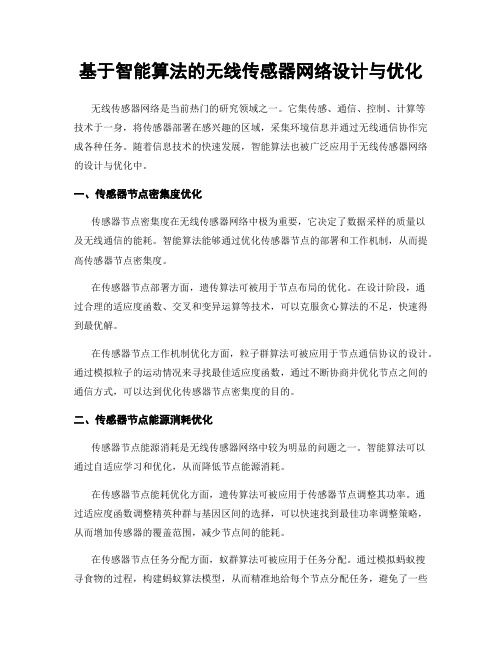
基于智能算法的无线传感器网络设计与优化无线传感器网络是当前热门的研究领域之一。
它集传感、通信、控制、计算等技术于一身,将传感器部署在感兴趣的区域,采集环境信息并通过无线通信协作完成各种任务。
随着信息技术的快速发展,智能算法也被广泛应用于无线传感器网络的设计与优化中。
一、传感器节点密集度优化传感器节点密集度在无线传感器网络中极为重要,它决定了数据采样的质量以及无线通信的能耗。
智能算法能够通过优化传感器节点的部署和工作机制,从而提高传感器节点密集度。
在传感器节点部署方面,遗传算法可被用于节点布局的优化。
在设计阶段,通过合理的适应度函数、交叉和变异运算等技术,可以克服贪心算法的不足,快速得到最优解。
在传感器节点工作机制优化方面,粒子群算法可被应用于节点通信协议的设计。
通过模拟粒子的运动情况来寻找最佳适应度函数,通过不断协商并优化节点之间的通信方式,可以达到优化传感器节点密集度的目的。
二、传感器节点能源消耗优化传感器节点能源消耗是无线传感器网络中较为明显的问题之一。
智能算法可以通过自适应学习和优化,从而降低节点能源消耗。
在传感器节点能耗优化方面,遗传算法可被应用于传感器节点调整其功率。
通过适应度函数调整精英种群与基因区间的选择,可以快速找到最佳功率调整策略,从而增加传感器的覆盖范围,减少节点间的能耗。
在传感器节点任务分配方面,蚁群算法可被应用于任务分配。
通过模拟蚂蚁搜寻食物的过程,构建蚂蚁算法模型,从而精准地给每个节点分配任务,避免了一些节点负载过重或负载过轻的情况,使得网络能量更加均衡,从而增加传感器网络的生命周期。
三、传感器节点数据采集质量优化数据采集质量是无线传感器网络中至关重要的指标之一,其直接影响到无线传感器网络的精度和效率。
智能算法可以优化数据采集质量,提高数据采集的效率和可靠度。
在数据采集质量优化方面,蜂群算法可被应用于传感器节点的数据融合算法中。
通过蜂群算法对数据进行分群,选择不同的聚类算法,带改进的k-means、DBSCAN、凝聚层次聚类算法等等,从而优化数据融合的模型,提高数据采集的精度和效率。
无线传感器网络及其发展
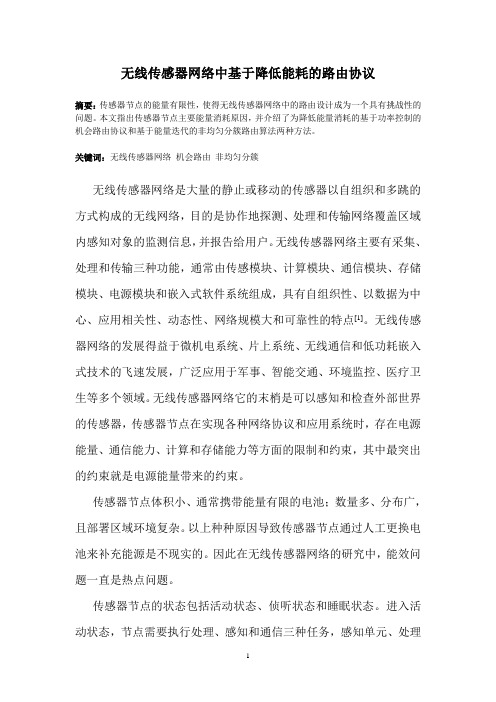
无线传感器网络中基于降低能耗的路由协议摘要:传感器节点的能量有限性,使得无线传感器网络中的路由设计成为一个具有挑战性的问题。
本文指出传感器节点主要能量消耗原因,并介绍了为降低能量消耗的基于功率控制的机会路由协议和基于能量迭代的非均匀分簇路由算法两种方法。
关键词:无线传感器网络机会路由非均匀分簇无线传感器网络是大量的静止或移动的传感器以自组织和多跳的方式构成的无线网络,目的是协作地探测、处理和传输网络覆盖区域内感知对象的监测信息,并报告给用户。
无线传感器网络主要有采集、处理和传输三种功能,通常由传感模块、计算模块、通信模块、存储模块、电源模块和嵌入式软件系统组成,具有自组织性、以数据为中心、应用相关性、动态性、网络规模大和可靠性的特点[1]。
无线传感器网络的发展得益于微机电系统、片上系统、无线通信和低功耗嵌入式技术的飞速发展,广泛应用于军事、智能交通、环境监控、医疗卫生等多个领域。
无线传感器网络它的末梢是可以感知和检查外部世界的传感器,传感器节点在实现各种网络协议和应用系统时,存在电源能量、通信能力、计算和存储能力等方面的限制和约束,其中最突出的约束就是电源能量带来的约束。
传感器节点体积小、通常携带能量有限的电池;数量多、分布广,且部署区域环境复杂。
以上种种原因导致传感器节点通过人工更换电池来补充能源是不现实的。
因此在无线传感器网络的研究中,能效问题一直是热点问题。
传感器节点的状态包括活动状态、侦听状态和睡眠状态。
进入活动状态,节点需要执行处理、感知和通信三种任务,感知单元、处理单元和通信单元上电,传感器节点开始正常工作。
侦听状态是传感器节点被布设后的初始状态,此时仅通信单元处于上电模式,感知和处理单元都被关闭,直到从簇头接收到消息,才会转换为其他状态。
在睡眠状态中,不执行任何任务,传感器节点会关闭大部分功能单元,只有传感器的传输模块处于上电状态,以便对接收到的报文及时做出响应[2]。
单位时间内节点三种状态消耗的能量依次减少,活动状态消耗能量最多,睡眠状态消耗能量最少。
物联网的关键技术无线传感器网络

物联网的关键技术无线传感器网络物联网的关键技术:无线传感器网络摘要:物联网的发展推动了无线传感器网络(Wireless Sensor Network,WSN)的快速发展,成为物联网的重要支撑技术之一。
本文将围绕无线传感器网络的概念、架构、节点设计与通信协议等方面进行探讨,并阐述在物联网中无线传感器网络的关键技术。
一、无线传感器网络的概念无线传感器网络是一种由大量分布式传感器节点组成的网络系统,节点之间通过无线通信进行数据传输。
每个传感器节点通常由传感器、嵌入式处理器、电源和通信模块等组成,能够感知和采集环境中的各种信息,并将数据传输至网络中。
二、无线传感器网络的架构无线传感器网络的架构一般包括传感器节点、中继节点、基站节点等。
传感器节点负责采集环境数据,并通过无线通信将数据传输至中继节点。
中继节点对数据进行处理和转发,将数据传输至基站节点。
基站节点负责数据的接收与处理,并可以与外界网络进行通信。
三、无线传感器网络的节点设计1. 能源管理:由于无线传感器节点通常采用电池供电,节点应具备低功耗特性。
节点设计中应考虑功耗优化技术,如睡眠模式、动态功率管理等,以延长传感器节点的工作寿命。
2. 传感器选择:根据应用需求选择合适的传感器,如温度传感器、湿度传感器、光照传感器等。
同时,还需考虑传感器的精确度、功耗、可靠性等指标。
3. 硬件设计:节点的硬件设计应满足小尺寸、低功耗的要求。
采用先进的制造工艺和集成电路设计,以提高性能并降低节点成本。
四、无线传感器网络的通信协议1. 网络层协议:常用的网络层协议包括LEACH、PEGASIS、SEP 等。
这些协议通过节点选择、数据聚合等技术,提高了传感器网络的能效和可扩展性。
2. 传输层协议:传输层协议用于数据的可靠传输。
常用的传输层协议有RTP、UDP、TCP等。
根据应用需求选择合适的传输层协议,以保证数据的可靠性和实时性。
五、无线传感器网络在物联网中的应用无线传感器网络在物联网中具有广泛的应用前景,包括智能家居、智慧城市、环境监测、农业领域等。
无线传感器网络中若干节能优化问题研究的开题报告

无线传感器网络中若干节能优化问题研究的开题报告一、研究背景和意义随着物联网的快速发展,无线传感器网络(Wireless Sensor Network,WSN)在环境监测、智能交通、智能家居等领域得到广泛应用。
由于无线传感器节点的能量有限,其能量消耗是制约无线传感器网络应用的主要因素之一。
为解决能量消耗过快的问题,必须对无线传感器网络进行节能优化。
优化无线传感器网络的节能策略,可以实现较长时间的持续工作,提高传感器网络的可靠性和可用性。
二、研究内容本研究基于以下几个方面的研究内容:1. 无线传感器网络能量管理无线传感器网络的能量管理是节能优化的重要方向。
研究如何对无线传感器网络进行能量管理,以达到节能目的,并保证传感器网络的数据传输、数据处理和节点本身的工作正常运行。
2. 研究无线传感器网络的睡眠调度睡眠调度可以实现无线传感器节点在非工作状态下休眠,以延长节点的运行时间。
研究不同的睡眠调度策略,以提高传感器网络的能量利用效率和网络的生存时间。
3. 研究混合能源无线传感器网络混合能源无线传感器网络是指利用多种能源(太阳能、热能、振动能等)来为传感器节点供电,以实现节能和延长传感器网络的运行时间。
研究混合能源无线传感器网络的优化策略,以提高传感器节点的能量利用效率和网络的生存时间。
4. 研究基于低功耗局域网(Low Power Wide Area,LPWA)技术的无线传感器网络LPWA技术是无线传感器网络中比较新兴的技术,由于其低功耗、低成本和广覆盖等特点,被认为是未来智能物联网的重要组成部分。
研究如何利用LPWA技术为无线传感器网络提供更加节能、高效的通信方式,可以大大提高传感器网络的利用效率和生存时间。
三、研究目标和研究方法本研究的主要目标是研究无线传感器网络中的若干节能优化问题,并探索相应的解决方案。
具体目标包括:1. 研究无线传感器网络的能量管理策略,以提高传感器网络的能量利用效率和生存时间。
无线传感器网络中的分布式随机感知理论研究

无线传感器网络中的分布式随机感知理论研究随着科技的不断发展,无线传感器网络(Wireless Sensor Network,WSN)作为一种新兴的网络通信技术也被广泛应用于多个领域中,如环境监测、智能交通、医疗保健等。
在无线传感器网络中,分布式随机感知(Distributed Random Sensing,DRS)技术的应用及研究已成为当前热点领域。
一、Distributed Random Sensing技术概述Distributed Random Sensing技术是一种利用多个分布式传感器节点随机感知环境中的信息,并将采集的信息进行整合、分析和传输的技术。
该技术利用了多个节点的协同作用,实现了大规模环境信息的感知及处理,从而能够提高网络的性能和可靠性。
DRS技术相对于其他传统的感知技术,具有以下优点:(1)能够充分利用网络中传感器节点的分布式特性,减少了单个节点对网络的影响,提高了网络的鲁棒性。
(2)DRS技术采用随机化的方法,保证了网络节点的均衡负载,减少了感知节点之间的冲突和重复。
(3)DRS技术对于节点失效和阻塞情况具有强大的容错能力,能够保证网络的长期稳定运行。
二、Distributed Random Sensing算法研究当前,DRS算法的研究重点主要集中在两个方面:一是感知信息的采集,包括节点选择和感知范围的确定;二是数据处理和传输,包括节点数据的处理和整合、协议设计等。
(1)节点选择和感知范围的确定传感器节点选择是一个非常重要的问题。
在DRS技术中,节点选择旨在确定哪些节点将参与到感知过程中。
当前研究主要关注以下两种节点选择算法:①基于覆盖的节点选择。
该算法是根据节点感知范围对节点进行选择的。
选择的节点能够监控所选择的区域,以提高网络感知的效率和精度。
②基于均衡负载的节点选择。
该算法是根据节点当前负载和饱和度来进行节点选择的。
选择的节点应该能够满足所指定的感知负载条件,以保证网络感知过程平衡和均衡。
无线传感器网络的研究进展

近年来,随着物联网技术的不断发展,无线传感器网络的数据传输技术也在不 断进步。例如,LoRa协议的提出,使得无线传感器网络在传输距离和稳定性方 面得到了很大的提升。此外,随着5G技术的不断普及,无线传感器网络也开始 采用5G技术进行数据传输,从而提高了传输速度和可靠性。
三、无线传感器网络的未来展望
关键词:无线传感器网络、研究 进展、应用前景、挑战、方向
一、无线传感器网络的概述
无线传感器网络是指由一组自组织、低功耗、微型化的传感器节点组成的网络, 通过无线通信技术协同地监测、感知和采集各种环境或目标的信息,实现对复 杂环境的智能感知和监测。无线传感器网络具有自组织、动态性、鲁棒性等特 点,被广泛应用于环境监测、智能交通、智能家居、农业生产等领域。
近年来,随着应用的深入,无线传感器网络在医疗、工业等领域的应用也开始 得到重视。例如,在医疗方面,无线传感器可以用于实时监测患者的生理参数 和健康状况,为医生诊断和治疗提供帮助。在工业方面,无线传感器网络可以 用于实现工厂设备的远程监控和维护,提高生产效率和降低成本。
3、数据传输方面
无线传感器网络中的数据传输是其核心功能之一。在数据传输方面,无线传感 器网络采用了多种技术手段,如直接传输、多跳传输、网状传输等。直接传输 是指传感器节点将采集到的数据直接传输给接收器或基站。多跳传输是指数据 从一个节点跳转到另一个节点,最终到达接收器或基站。网状传输是指整个网 络中的每个节点都充当路由器,将数据传输到更远的节点,最终到达接收器或 基站。
2、技术挑战方面
虽然无线传感器网络已经得到了广泛的应用,但是在未来仍面临着一些技术挑 战。例如,如何提高网络的覆盖范围和连通性、如何降低节点的功耗和提高其 寿命、如何提高网络的安全性和隐私保护等。这些技术挑战需要不断地进行研 究和探索,以便更好地满足实际应用的需求。
无线传感器网络中的分布式多目标优化算法

无线传感器网络中的分布式多目标优化算法无线传感器网络是由许多自主节点组成的自组织网络,节点可以感知、存储、处理、通信等多种功能。
在工业、农业、环境监测等领域,无线传感器网络被广泛应用,而其中一个重要问题是网络能源的消耗。
因此,如何设计有效的分布式多目标优化算法,以最大程度地降低能源消耗,成为了当前无线传感器网络研究的热点。
分布式多目标优化算法的背景在无线传感器网络中,传感器节点的能量来源有限,受制于电池容量、太阳能电池、燃料电池等因素,因此如何提高无线传感器网络的能源利用效率是一项必须解决的问题。
同时,为了保证网络可靠和安全运行,业务质量、数据传输信号质量、传输速率等指标也需要得到保证。
因此,在设计优化算法时需要同时考虑不同的指标。
分布式多目标优化算法的定义分布式多目标优化算法旨在解决多目标优化问题,并且数据分散分布在不同的节点中,需要通过协作来进行全局优化。
其目的是通过节点之间的协作和通信,达到最优解或次优解。
与传统的优化方法相比,分布式多目标优化算法可以充分考虑节点能源有限的情况,能够使得网络的能源更加高效的利用,提高网络长期稳定运行的能力。
分布式多目标优化算法的优势分布式多目标优化算法具有以下特点:1. 支持分布式协作。
分布式多目标优化算法可以将算法中的任务和数据分配给不同的节点,让每个节点分别完成任务,同时通过协作和通信,逐步优化自身结果,达到全局最优解。
2. 支持节点能量优化使用。
由于节点能量数量有限,分布式优化算法可以最大程度地降低节点能量的消耗,给予节点使用优化建议,减缓节点能量消耗速度,提高节点的长期可靠性。
3. 支持实时响应。
由于节点具有较强的自主性,能够对感知到的信息做出及时的反应和响应,因此,分布式多目标优化算法具有处理数据的时效性,从而能够在实时性领域中得到应用。
分布式多目标优化算法的研究现状针对分布式多目标优化算法,目前国内外学者已经做了大量的研究。
其中,比较有代表性的算法有遗传算法(Genetic Algorithm)、蚁群算法(Ant Colony Algorithm)、模糊控制(Fuzzy Control)等。
无线传感器网络中基于动态规划的节点高效部署算法

无线传感器网络中基于动态规划的节点高效部署算法作者:许秀兰李克清来源:《计算机应用》2013年第11期摘要:针对传感器提供的信息不可靠导致的节点部署问题,研究了4种不同的静态无线传感器网络(WSN)部署形式,并将这4个组合优化问题归纳为NP完全问题,提出了一种基于动态规划的不确定性感知节点部署算法进行求解。
算法首先为感兴趣区域内的传感器节点找到其最佳的K个部署位置,然后从K个部署位置中选择最优部署方案。
该算法能够在保证覆盖范围和连接性的前提下确定最小数量的传感器及其位置。
仿真实验结果表明,相对于当前最新的其他传感器部署策略,所提算法在均匀覆盖、优先覆盖要求以及网络连接性下的性能都更优。
关键词:无线传感器网络;节点部署;NP完全问题;动态规划;节点数目0引言综合了无线通信技术、传感器技术、嵌入式计算技术和分布式信息处理技术的无线传感器网络(Wireless Sensor Network, WSN),是目前国际上前沿热点的研究领域。
传感器部署问题作为无线传感网络的一个基本问题,近年来引起广泛关注[1-4]。
实际上,在感兴趣区域(Region of Interest, RoI)部署的传感器数量及其位置,决定了网络的拓扑结构,进而影响网络诸多内在属性,比如覆盖范围、连接性、成本及运行寿命等。
因此,一个无线传感网络的性能很大程度上取决于传感器的部署。
本文主要针对高效的传感器节点部署算法进行了研究,本文工作原创性贡献有:1)将静态无线传感网络部署问题描述为4种具体情况。
2)根据基于证据的传感器覆盖模型,提出了四种不确定性感知部署算法:SE2BDA(simplified algorithm of efficient evidencebased sensor deployment algorithm)、E2BDAP(efficient evidencebased sensor deployment algorithm preferential coverage objective)、E2BDAC(efficient evidencebased sensor deployment algorithm preferential network connectivity objective)和E2BDA。
- 1、下载文档前请自行甄别文档内容的完整性,平台不提供额外的编辑、内容补充、找答案等附加服务。
- 2、"仅部分预览"的文档,不可在线预览部分如存在完整性等问题,可反馈申请退款(可完整预览的文档不适用该条件!)。
- 3、如文档侵犯您的权益,请联系客服反馈,我们会尽快为您处理(人工客服工作时间:9:00-18:30)。
I.J. Information Technology and Computer Science, 2013, 08, 101-108Published Online July 2013 in MECS (/)DOI: 10.5815/ijitcs.2013.08.10Distributed Algorithms for Maximizing Lifetime of WSNs with Heterogeneity and AdjustableSensing Range for Different DeploymentStrategiesSamayveer SinghDepartment of Computer Engineering, Netaji Subhas Institute of Technology, New Delhi, IndiaE-mail: samayveersingh@Ajay K SharmaDepartment of Computer Science and Engineering, National Institute of Technology, Jalandhar, Punjab, IndiaE-mail: sharmaajayk@nitj.ac.inAbstract—Focus of this paper is on energy heterogeneity and distributed algorithms for scheduling and adjustable range. The problem of lifetime enhancement of wireless sensor networks is dealt with the adjustment of transmission or sensing range of the sensor nodes and implementation of heterogeneous energy model. In this work, we deploy the sensor nodes in 2-D using triangular, square, and hexagonal tiles. The initial energies of the sensors and their positions along with the positions of targets are known. For this environment, we investigate the maximum achievable lifetime using heterogeneous deterministic energy efficient protocol with adjustable sensing range (HADEEPS) and heterogeneous load balancing protocol with adjustable sensing range (HALBPS). We observe that deploying the sensors in triangular tiles gives better lifetime.Index Terms—Energy Efficiency, Heterogeneity, Lifetime, DeploymentI.IntroductionA wireless sensor networks (WSNs) is defined as a network of nodes that have small size and low-battery power and can be deployed to sense the environment for information collection. The collected information is sent through wireless links using multiple hops to a sink or controller, which can use it locally or further transmits to other networks through a gateway. A node in sensor network consists of CPU, memory, battery, and transceiver. The CPU performs data processing, memory stores data, battery provides energy, and the transceiver receives and sends data. The nodes can be stationary or mobile, location-aware or location-unaware, homogeneous or heterogeneous. The nodes in sensor networks can be individually addressable or group-addressable in which the aggregated data is communicated.One of the important issues in sensor networks is power supply that is constrained by battery size, which normally cannot be enhanced. Thus, optimal use of the sensor energy has a great impact on the network lifetime [1]. This can be done either scheduling the sensor nodes to alternate between active and sleep mode or adjusting their sensing range [2]. The techniques that help enhance network lifetime can be either centralized or distributed. In former case, a single node has access to the entire network information that is used to determine scheduling. In the later case, a sensor can exchange information with its neighbors and that information is used to make scheduling decisions. The distributed algorithms require local (e.g., nearest neighbor) information due to limited memory, computing, and communication capabilities of the sensors. Scheduling is a very important aspect for the network lifetime. Paper [3] discusses a distributed algorithm based on using the faces of the graph. If all faces covered by a sensor are also covered by other sensors with higher battery level and these sensors are monitoring the region, then the first sensor goes into sleep state. This work has been extended in [4] and the resultant method is termed as the load balancing protocol (LBP). In this paper, they discuss maximizing sensor network lifetime for the given monitoring region using battery life and energy consumption rate for each sensor. Brinza and Zelikovsky [5] discuss how the sensors can interchange idle and active modes while monitoring and communicating. They discuss a new deterministic energy-efficient protocol for sensor networks (DEEPS) for prolonging the network lifetime. In [1,2,6], the network lifetime enhancement has been discussed by considering adjustable sensing range unlike the fixed sensing range in [4,5]. Papers [1,7] discuss a mechanism for making maximum disjoint102Distributed Algorithms for Maximizing Lifetime of WSNswith Heterogeneity and Adjustable Sensing Range for Different Deployment Strategiescovers sets of the sensors in such a way that one set can monitor all targets. These sets are randomly deployed to monitor the targets and have adjustable sensing range. The duration of the active set in [1] is energy dependent whereas in [7] all active sets have fixed time interval. The energy is conserved by activating the cover sets successively. The sensors from the current active set are responsible for monitoring all targets and transmitting the collected data to sink; and remaining go to sleep mode. In case a sensor is a member of multiple cover sets, such set covers leads to increase in the network lifetime. Paper [6] discusses the optimal scheduling by assigning the best times for each cover in order to maximizing the lifetime based on the ratio of number of uncovered targets covered by sensor and weight multiply by distance between sensor, and target of a target-covering sensor network. In [8], the network lifetime has been increased by constructing local cover sets consisting of sensors that can cover local targets. The cover sets are prioritized by using some properties of the lifetime dependency graph model. This work has been extended in [9] by enabling the sensors to determine their sleep-sense cycles based on specific coverage goals. In paper [10], a lifetime dependency (LD) graph model is discussed that captures the interdependencies between these cover sets by modeling each cover as a node and having the edges represent shared sensors. They also give some properties of the optimal schedule that relate to the LD graph into sleep-sense cycles. Paper [11] discusses the innovative models and heuristics by using exponential state space of the maximum lifetime sensor cover problem.In [12], some mechanism is discussed to make sensors active. In this paper, the area left uncovered on removing a sensor is determined and it is termed as the sensing denomination (SD) of that sensor. Based on the location information of neighboring sensors, each sensor calculates its SD value in a distributed manner. The sensors with high SD have high probability of becoming active. If the cooperative nature of a sensor with its peers is considered, it leads to longer lifetime. This aspect has been addressed in [13] and named as multiple sensors to multiple targets (M-M) probabilistic target coverage problem. In M-M, multiple sensors cover multiple targets cooperatively and simultaneously with a given realistic detection probability threshold of each target. In [14,15,16], different deployments of sensors in 2-D are discussed, which include uniform arrangements in triangular, square, or hexagonal tiles and report that the triangular deployment is better as far as network lifetime is concerned. The network lifetime can be increased by providing energy heterogeneity to the sensors. The energy heterogeneity is addressed in [17,18,19]. These discuss 3-level heterogeneity models in which three types of sensor nodes: normal nodes, advance nodes and super nodes are considered. The advance nodes have more energy than the normal ones and the super nodes have more energy than the advance nodes. Their numbers are in reciprocal order because of the cost factor.In this paper, we modify two distributed algorithms: deterministic energy efficient protocol with adjustable sensing range (ADEEPS) and load balancing protocol with adjusting sensing range (ALBPS) by incorporating 3-level energy heterogeneity. The resultant algorithms increase the network lifetime and are named as heterogeneous deterministic energy efficient protocol with adjustable sensing range (HADEEPS) and heterogeneous load balancing protocol with adjusting sensing range (HALBPS). Furthermore, the sensors are deployed in different tiles: triangular, square and hexagonal tiles similar to that discussed in [14-16]. The remaining paper is organized as follows. Section 2 discusses the network model. Section 3 discusses the proposed algorithms: HALBPS and HADEEPS. Simulation procedure is discussed in section 4. Section 5 discusses the results and the paper is concluded in section 6.work ModelIn this section, we discuss different aspects of network model that include node types with their locations, their deployment strategies, and adjustable sensing range.Consider N sensor nodes that are distributed randomly and uniformly over the monitoring field. We assume the following:∙It is a static and densely deployed network in 2-D.∙Each sensor node has information about its neighbouring sensors and targets, besides its own IDs and position.∙Each sensor nodes has adjustable sensing range and its transceiver has the capability to change transmission power for different transmission ranges. ∙The sensor nodes are assumed of three types: normal, advance, and super nodes are considered like in [17-19]. The super nodes have maximum energy but reciprocal in numbers and the normal nodes have minimum energy; hence reciprocal in numbers.In this network model, the sensors are arranged in sets such that at any time only one cover set is active to monitor the environment and others are in sleep state to save the energy. The cover sets periodically become active according to monitoring schedule and that period is generally called reshuffle period.Initially, the super nodes cover the targets. In case some targets are not covered by the super nodes, then some of the advance nodes that can monitor uncovered targets become active nodes. If some targets are still not covered by super and advance nodes, then some of the normal nodes that can monitor the uncovered targetsbecome active nodes. The network lifetime is obtained by adding the times of each monitoring schedule. The network lifetime is increased using ALBPS and ADEEPS by incorporating energy heterogeneity and different deployments strategies.2.1 Node Deployment StrategiesThe lifetime of a network is highly dependent on the nodes arrangement that in turn affects energy consumption in WSNs.a) Triangular tilesb) Square tilesc) Hexagonal tilesFig. 1: uniform arrangement of the sensor nodesThere are several deployments/arrangements, but the most commonly used are triangle, square, and hexagonal in 2-dimensional region [14-16]. They are generally deployed manually by fixing the nodes in predefined locations to analyze for minimum energy consumption and hence the maximum lifetime of a WSN. Figs. 1(a)-(c) show deployment of sensor nodes in triangular, square, and hexagonal tiles [14-16].a) Triangle Deployment: In this deployment, the sensors are placed at each corner of a unilateral triangle. Each internal node shares 6 triangles at any point. We represent the area of a triangle in terms of the area of the exterior circle. The radius of the exterior circle d =√r, where r denotes the side length of the unilateral triangle. The area of the network consisting of N nodes is N √r 2 = N√d 2 [14-16] (refer Fig. 2(a)).b) Square Deployment: In this deployment, the sensors are placed at each corner of the square. The area covered by the network consisting of N nodes is given by 2Nd 2, where d is the radius of exterior circle. (refer Fig. 2(b)).c) Hexagon Deployment: A hexagon is a collection of six unilateral triangles as shown in Fig. 2(c). Each hexagon has 6 corners at which a sensor is deployed.The total area covered by N nodes is given by√ 2(refer Fig. 2(c)).Fig. 2: Coverage d, in triangular, square, hexagonal arrangementIII. Proposed WorkIn this section, we discuss HALBPS and HADEEPS algorithms that are ALBPS and ADEEPS equipped with heterogeneity in sensor nodes. The sensor nodes are deployed in triangular, square, and hexagonal tiles. A sensor at any given point of time can be in one of the three states: active state, idle state, and deciding state. In active state, it monitors the targets and in idle state it listens to other sensors, but does not monitor targets. In deciding state, it monitors targets and will change its state to either active or idle soon. The characteristics of the HALBPS and HADEEPS are discussed in subsections 3.1 and 3.2, respectively.d ddd3.1HALBPSThis protocol is characterized by adjustable sensing range, deployment strategy, and node heterogeneity. With the help of load balancing, the HALBP is used to keep as many sensors alive as possible and try to let them die simultaneously. Here aliveness is different from activeness. Initially, each sensor disseminates its battery level and covered targets to its neighbors. It then stays in the deciding state with its maximum sensing range for finding sensor cover schedules. Each sensor will change its state as per following rules:When a sensor is in the deciding state with range r, it will change its state to -Active state with sensing range r, if there is a target at range r which is not covered by any other active or deciding sensors.Deciding State,if all covered targets at range r are covered by either active or deciding sensors with a more prominent monitoring time. In that case, it decreases its sensing range to the next furthest away target.Idle state, if the sensor decreases its range to zero.3.2HADEEPSFirst we divide the targets into sinks and hill. The hill target is identified by the energy accumulated from different sensors that can monitor it and has maximum energy. The remaining targets are sinks. There is one sensor-in-charge for each target besides that sensor monitoring it. The maximum lifetime of a target is defined in terms of sensor lifetime. It is the sum of the sensors’ l ifetime, which cover that target. To determine the in-charge sensor of a target, following rules should be followed:∙For the sink target, the sensor covering it with the highest lifetime and the sink being the poorest target, is considered as the in-charge of that target.∙For the hill target, among the sensors covering the hill and the poorest target has the largest lifetime. Then that sensor is considered as the in-charge of that target. If there are several such sensors, the richest one is the in-charge.The in-charge sensor remains active and others are in sleep mode. In order to find the sensor cover schedule, each sensor initially broadcasts its battery and targets covered to its neighbouring sensors in its range and then it stays in the deciding state with its maximum sensing range. Assuming the sensor in deciding state with sensing range r, it changes its state to:- Active state with sensing range r, if there is a farthest target at range less than or equal to r which is not covered by any other active or deciding sensors.- Idle state, whenever the sensor, not in-charge of any target except those already covered by the active sensors, switches itself to idle state.For both the algorithms, the sensors make decision to go to active or idle state and stay in that state for a specified period of time, called shuffle time, or till the active sensor exhausts its energy. When the energy of an active sensor goes down below a threshold, it informs neighboring sensors and then goes to the deciding state with its maximum sensing range. A network will fail if there is a target which is not covered by any sensor.IV.Simulation ParametersWe describe the parameters required to carry out them. Our methods: HALBPS and HADEEPS are simulated by deploying sensors in triangular, square, and hexagonal tiles. For simulation environments, a static wireless network of sensors and targets of 100Mx100M in which the sensors and targets are deployed randomly and their locations are known. We measure the network lifetime with respect to the number of sensors for different sensing ranges, numbers of targets using two energy models: linear and quadratic energy models. The parameters used in simulation are given in Table I.Table 1: Simulation ParametersParameters Symbols ValuesNumber of Sensors S 40 ~ 200Number of Targets T 25 and 50 Initial Energy of a normal Sensor E0 2J Adjustable Sensing Ranges (r1, r2) 30M and 60MThe energies of a normal, advanced, and super node are assumed as E0, E0(1+), and , respectively, where and are positive real numbers. For taking total number of sensor nodes as n, the sum of the number of super and advanced nodes are given by n*m, where m is a positive fraction and the remaining n*(1-m) are normal nodes. Out of n*m nodes, n*m*m0 are super nodes, where is m0 a positive fraction, and the remaining - are advanced nodes. We employ two commonly used energy models: linear and quadratic energy model [18]. In linear model, the energy varies linearly with respect to distance and in the quadratic model, the energy varies quadratically with respect to distance. We have implemented the algorithms in C++.V.Results and DiscussionsWe have considered two cases for analyzing the network lifetime using heterogeneity and different deployments in 2-D.Case-I: m=0.2, m 0=0.5, α=2, β=1 Case- II:m=0.2, m 0=0.5, α=1, β=2For each case, different scenarios have been taken: (a) sensing range as 30M and number of targets as 25, (b) 30M as sensing range and 50 targets, (c) 60M as sensing range and 25 targets, (d) 60M as sensing range and 50 targets. For all these inputs, we have employed both linear and quadratic energy models; thus, totaling 8 different scenarios. Figs. 4(a)-(d) show the network lifetime with respect to the number of sensor nodes for case –I and scenario (a) using triangular, square, and hexagonal deployments of the sensors for HALBPS and HADEEPS methods. For other combinations, similar results have been obtained and they have been shown in Tables II & III. Because of the repetitive nature of graphs, we have not shown remaining results graphically.(a)(b)(c)(d)Fig. 4: lifetime for sensor networks in case of (a) HADEEPS with Linear Energy Model (b) HADEEPS with Quadratic Energy Model (c) HALBPS with Linear Energy Model (d) HALBPS with Quadratic Energy ModelIt is evident from these figures (Figs 4(a)-(d)) that as the number of sensors increases, the network lifetime also increases. It is intuitive because increasing the number of sensors increases the energy in network and hence network lifetime. The results further show comparison of network lifetime using triangular, square, and hexagonal deployment. We observe that the overall network lifetime significantly improves with both protocols for deploying sensors in triangular tiles for both linear and quadratic energy models. For using 200 sensors, the lifetimes obtained in the HADEEPS for deploying in triangular, square, and hexagonal tiles are 1296, 800, and 469, respectively, for linear energy model and, for quadratic energy model, are 176, 81, 38 hours. For same inputs and the HALBPS protocol, the network lifetimes are 1274, 753, 481 hours for linear energy model and for quadratic energy model are 172, 80, 35 hours. For other cases, the results are given in200400600800100012001400406080100120140160180200L i f e t i m e (H o u r s )Triangular SquareHexagonalNo. of Sensors20406080100120140160180200406080100120140160180200L i f e t i m e (H o u r s )Triangular SquareHexagonalNo. of Sensors200400600800100012001400406080100120140160180200L i f e t i m e (H o u r s ) Triangular Square HexagonalNo. of Sensors20406080100120140160180200406080100120140160180200L i f e t i m e (H o u r s )Triangular SquareHexagonalNo. of SensorsTables II and III for case-I and II, respectively. Weobserve from Tables-II and III that, in all cases, theresults have similar nature.Table 2: network lifetime using linear and quadratic energy models in HADEEPS and HALBPS for triangular, square, hexagonal deployments at different sensing range, different targets, and 200 sensors in 100M x 100M area for case-I1.Proposed Algorithms Energy ModelSensor Network Lifetime (in hours) at 200 Number of Sensor in hoursTriangular tiles Square tiles Hexagonal tiles HADEEPS( 30M Sensing Range & 25 Targets)Linear 1296 800 469Quadratic 176 81 38 HALBPS( 30M Sensing Range & 25 Targets)Linear 1274 753 481Quadratic 172 80 352.HADEEPS( 60M Sensing Range & 25 Targets)Linear 1672 1072 646Quadratic 190 93 44 HALBPS( 60M Sensing Range & 25 Targets)Linear 1491 988 631Quadratic 182 89 423.HADEEPS( 30M Sensing Range & 50 Targets)Linear 975 607 357Quadratic 143 67 30 HALBPS( 30M Sensing Range & 50 Targets)Linear 897 556 271Quadratic 104 42 144.HADEEPS( 60M Sensing Range & 50 Targets)Linear 1134 739 488Quadratic 153 74 34 HALBPS( 60M Sensing Range & 50 Targets)Linear 1011 695 447Quadratic 119 55 25Table 3: network lifetime using linear and quadratic energy models in HADEEPS and HALBPS for triangular, square, hexagonal deployments at different sensing range, different targets, and 200 sensors in 100M x 100M area for case-II1.Proposed Algorithms Energy ModelSensor Network Lifetime at 200 Number of Sensor in hoursTriangular tiles Square tiles Hexagonal tiles HADEEPS( 30M Sensing Range & 25 Targets)Linear 1208 748 439Quadratic 166 75 35 HALBPS( 30M Sensing Range & 25 Targets)Linear 1189 703 448Quadratic 163 74 322.HADEEPS( 60M Sensing Range & 25 Targets)Linear 1557 996 601Quadratic 179 85 41 HALBPS( 60M Sensing Range & 25 Targets)Linear 1386 919 589Quadratic 170 82 393.HADEEPS( 30M Sensing Range & 50 Targets)Linear 903 567 331Quadratic 133 63 28 HALBPS( 30M Sensing Range & 50 Targets)Linear 838 518 252Quadratic 97 39 134.HADEEPS( 60M Sensing Range & 50 Targets)Linear 1057 693 453Quadratic 143 69 32 HALBPS( 60M Sensing Range & 50 Targets)Linear 937 649 420Quadratic 111 52 23VI.ConclusionsIn this paper, the energy heterogeneity in the sensor nodes and their deployment in 2-D in the form of triangular, square, and hexagonal have been discussed for both linear and quadratic energy models. The proposed methods - HADEEPS and HALBPS provide longest network lifetime for deploying sensors intriangular tiles for both energy models. The lifetime in case of triangular deployment is about two times more than that of the square deployment and three times more than that of the hexagonal deployment. Thus, in triangular deployment, the energy consumption has been found minimum.References[1]M. Cardei, J. Wu, and M. Lu, ―Improving networklifetime using sensors with adjustable sensing ranges,‖ Int. Journal of Sensor Networks, (IJSNET), 2006, 1(2).[2]M. Cardei, J. Wu, N. Lu, and M.O. Pervaiz,―Maximum Network Lifetime with Adjustable Range‖, IEEE Int. Conf. on Wi reless and Mobile Computing, Networking and Communications (WiMob’05), Aug. 2005.[3]P. Berman, G. Calinescu, C. Shah, and A.Zelikovsky, ―Power efficient monitoring management in sensor networks,‖ Wireless Communications and Networking Conf. (WCNC), 2004, vol.4, pp. 2329–2334.[4]P. Berman, G. Calinescu, C. Shah and A.Zelikovsky, ―Power Efficient Monitoring Management in Sensor Networks,‖ IEEE Wireless Communication and Networking Conf.(WCNC’04), Atlanta, March 2004, pp. 2329-2334.[5] D. Brinza, And A. Zelikovsky, ―DEEPS:Deterministic Energy-Efficient Protocol for Sensor networks‖, ACIS International Workshop on Self-Assembling Wireless Networks (SAWN’06), Proc.Of SNPD, 2006, pp. 261-266.[6] A. Dhawan, C. T. Vu, A. Zelikovsky, Y. Li, and S.K. Prasad, ―Maximum Life time of Sensor Networks with Adjustable Sensing Range,‖ 2nd ACIS Int. Workshop on Self assembling Wireless Networks, (SAWN 2006), Las Vegas, NV, 2006, June 19-20.[7]M. Cardei, M.T. Thai, Y. Li, and W. Wu, ―Energy-efficient target coverage in wireless sensor networks‖, In Proc. Of IEEE Infocom, 2005.[8]S. K. Prasad and A. Dhawan, ―DistributedAlgorithms for lifetime of Wireless Sensor Networks Based on Dependencies Among Cover Sets‖. In Proceedings of the 14th Int. Conf. on High Performance Computing, Springer, 2007, pp. 381-392.[9] A. Dhawan and S. K. Prasad, ―A DistributedAlgorithmic Framework for Coverage Problems in Wireless Sensor Networks‖. In Proceedings of the 22nd IEEE Parallel and Distributed Processing Symposium, 2008.[10]A. Dhawan, and S. K. Prasad, ―Energy efficientdistributed algorithms for sensor target coveragebased on properties of an optimal schedule,‖ HiPC:15th Int. Conf. on High Performance Computing,LNCS 5374, 2008.[11]A. Dhawan, ―Maximizing the Lifetime of WirelessSensor Networks‖, Physical Scien ces, Engineeringand Technology, Wireless Sensor Networks / Book1‖, 2012, ISBN 979-953-307-825-9.[12]J. Lu, and T. Suda, ―Coverage-aware self-scheduling in sensor networks,‖ 18th AnnualWorkshop on Computer Communications (CCW)2003, pp. 117–123.[13]J. W. Huang, C. M. Hung , K. C. Yang and J. S.Wang, ―Energy-efficient probabilistic targetcoverage in wireless sensor networks,‖ 17th IEEEInt. Conf. on Networks (ICON), Singapore, 2011,14-16 Dec. 2011, pp. 53 – 58.[14]M. Khan, G. Pandurangan and B. Bhargava,―Energy-Efficient Routing Schemes for SensorNetworks‖, Technical Report, West Lafayette, IN47907 CSD TR #03-013, May 2003.[15]M. Khan, G. Pandurangan and B. Bhargava,―Energy-Efficient Routing Schemes for WirelessSensor Networks‖,Technical Report, CSD TR 03-013, Department of Computer Science, PurdueUniversity, July 2003.[16]E. S. Biagioni and G. Sasaki, ―Wireless SensorPlacement for Reliable and Efficient DataCollection,‖ hicss, 36th Annual Hawaii Int. Conf.on System Sciences (HI CSS’03), 2003, vol. 5,pp.127b.[17]D. Kumar, T. S. Aseri, and R. B. Patel, ―EEHC:Energy efficient heterogeneous clustered schemefor wireless sensor networks‖, Int. Journal ofComputer Communications, Elsevier, 2009, 32(4):662-667.[18]Y. Mao, Z. Liu, L. Zhang, and X. Li, ―AnEffective Data Gathering Scheme inHeterogeneous Energy Wireless Sensor Networks,‖ Int. Conf. on Computational Science andEngineering, 2009, vol. 1, pp.338-343.[19]D. Kumar, T. S. Aseri, and R.B Patel ―EECHE:Energy-efficient cluster head election protocol forheterogeneous Wireless Sensor Networks,‖ inProceedings of ACM Int. Conf. on Computing,Communication and Control-09 (ICAC3’09),Bandra, Mumbai, India, 23-24 Jan. 2009, pp. 75-80.[20]A. Dhawan, ―Distributed Algorithms forMaximizing the Lifetime of Wireless SensorNetworks‖, Doctor of Philosophy, Disserta tionUnder the direction of S. K. Prasad, December2009, Georgia State University, Atlanta, Ga 30303.Authors’ ProfilesSamayveer Singh: received hisB.Tech. in Information Technologyfrom Uttar Pradesh TechnicalUniversity, Lucknow, India in 2007and his M.Tech. in ComputerScience & Engineering fromNational Institute of Technology,Jalandhar, India, in 2010. He is pursuing his PhD in the Department of Computer Engineering, Netaji Subhas Institute of Technology, New Delhi, India. His research interest includes wireless sensor networks.Ajay K Sharma: received his BEin Electronics and ElectricalCommunication Engineering fromPunjab University Chandigarh,India in 1986, MS in Electronicsand Control from Birla Institute ofTechnology (BITS), Pilani in the year 1994 and PhD in Electronics Communication and Computer Engineering in the year 1999. He is presently working as Professor in Computer Science & Engineering in National Institute of Technology, Jalandhar. His major areas of interest are broadband optical wireless communication systems and networks, dispersion compensation, fiber nonlinearities, optical soliton transmission, WDM systems and networks, Radio-over-Fiber (RoF) and wireless sensor networks and computer communication. He has published 215 research papers in International/National Journals /Conferences and 12 books. He has supervised 11 Ph.D. and 28 M.Tech. theses. He has completed three R&D projects funded by Government of India. He is associated to implement the World Bank project of 209 Million for Technical Education Quality Improvement programme of the institute. He is technical reviewer of reputed international journals. He was a member of technical Committee on Telecom under International Association of Science and Technology Development (IASTD) Canada for the term 2004-2007 and he is Life member of Indian Society for Technical Education (I.S.T.E.), New Delhi。
